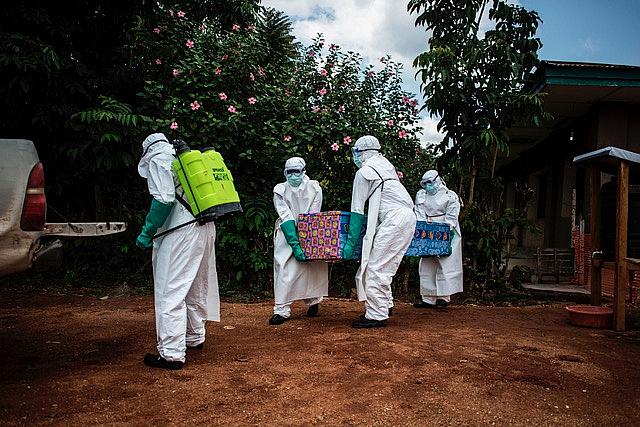Reporting beyond the anecdote reveals deeper truths about Ebola outbreak

(Photo: John Wessels/AFP/Getty Images)
In reporting on complex disease outbreaks, there is enormous value in examining narratives beyond the anecdote.
During the height of the Ebola virus outbreak in 2014, I met Dr. Pardis Sabeti, professor of organismic and evolutionary biology at Harvard University. At the time, her role in the response to the outbreak — she led the team that sequenced virus genomes from infected patients — easily lent itself to a profile story. Our conversations over the subsequent months left me with a choice: report on the experience of one scientist, or dig deeper to find whether there was a shared experience which the public should be made aware and from which the global community could learn.
Attempting the latter was a huge risk during a fast spreading outbreak and a seemingly faster news cycle. That anecdote could have been a story, one that would not have needed as much time or resources to report. But Sabeti’s firsthand account of the outbreak and my reporting showed us that collective experiences during the current Ebola outbreak — especially those that hindered progress — were indicative of how individuals and organizations respond during outbreaks in general.
Our hypothesis-driven work over three years became the premise for our book, “Outbreak Culture.” In it, Sabeti and I show that experiences during the 2014 Ebola outbreak were not specific to the time period, nor the geography where the outbreak hit. Nor were many of the problems — such as perverse incentives, poor policies, indecision, and unaccountability — specific to Ebola at all. In fact, the mindset and behaviors we’ve documented transcend any particular pathogen, and can be found in most large-scale epidemics. We define the actions that occur — or, at times, inactions — in the beginning stages of an outbreak as “outbreak culture.” Some of the common features of outbreak culture include fear, the instinct to protect oneself, others, or institutions, and the desire to exploit individuals or environments in the midst of chaos.
Both journalists and scientists respect the investigative process to produce information worth sharing with the public. It can become challenging for journalists to embrace the process when timeliness is critical to news coverage. However, slowing down in the reporting process can provide a more comprehensive view. We anchored our investigation by conducting a scientific study and through traditional shoe-leather journalism. We analyzed data from an original survey and interviews of Ebola responders. What we learned was that outbreak culture is a mindset that transcends time.
Here are a few additional techniques to consider when looking for story angles on infectious disease outbreaks:
Look beyond the pathogen. The scientific community was still learning about the particular strain of Ebola and the outbreak’s point of origin, and a potential vaccine for the disease had never been tested on humans when the outbreak hit in early 2014. It’s clear the world was unprepared for a large-scale epidemic of the virus. There is no doubt that the biology of a pathogen plays a large role in infection and death rates, but there is more to an epidemic than the virus itself. Consider the physical, sociological and geo-political environments that help or hinder a pathogen from spreading. Consider the man-made systems that exist — or perhaps, don’t exist — for responding to major public health emergencies. How well do these systems function? What are individuals, communities, or organizations doing to help one another? How are they getting in their own way?
Communicate uncertainties. How news stories frame an outbreak has a lot to do with how the public responds. During some outbreaks, the scientific community is learning about the pathogen as the outbreak is unfolding. There can be a lot we don’t know. The stakes are high and misinformation can fuel hysteria among an already fearful public. It is important for journalists to communicate uncertainty. We should not equate communicating uncertainty with incompetence. Indeed, uncertainty is a factual account of the state of occurrences in many outbreaks, so it should be reflected in our reporting as journalists. These stories can be framed simply as, “Here’s what we know. Here’s what we don’t know,” and developed over time.
Beware of false equivalencies. As we saw with Ebola in the U.S., some decisions by politicians and public health officials are made to appeal to public fear rather than based on science. This isn’t limited to outbreak scenarios. Public figures with no scientific background use their platform to advocate for policies, actions, or treatments with limited scientific evidence. Giving considerable attention in stories to claims unsupported by scientific evidence can create a false notion of balance. Don’t let louder voices obscure the facts. We should give heavier weight to scientific evidence than claims driven by agendas, regardless of who is speaking.
Highlight solutions. The environment during public health crises can be chaotic and confusing. It’s easy in retrospect to highlight everything that went wrong. It serves the public better to focus on solutions rather than place blame. That’s why it was important for us to weave into our book ways in which individuals and organizations undertook heroic efforts to curb the Ebola epidemic.

